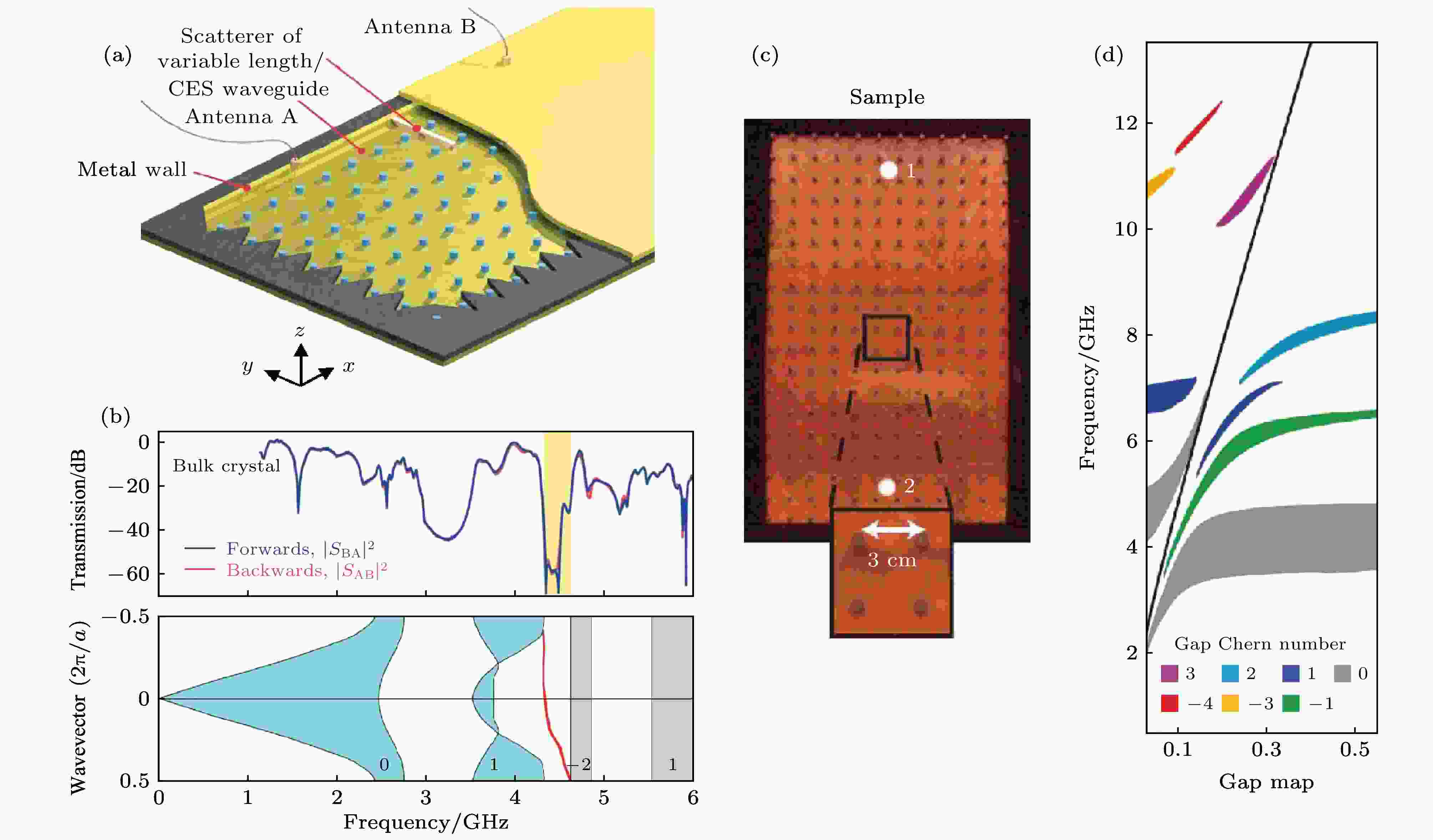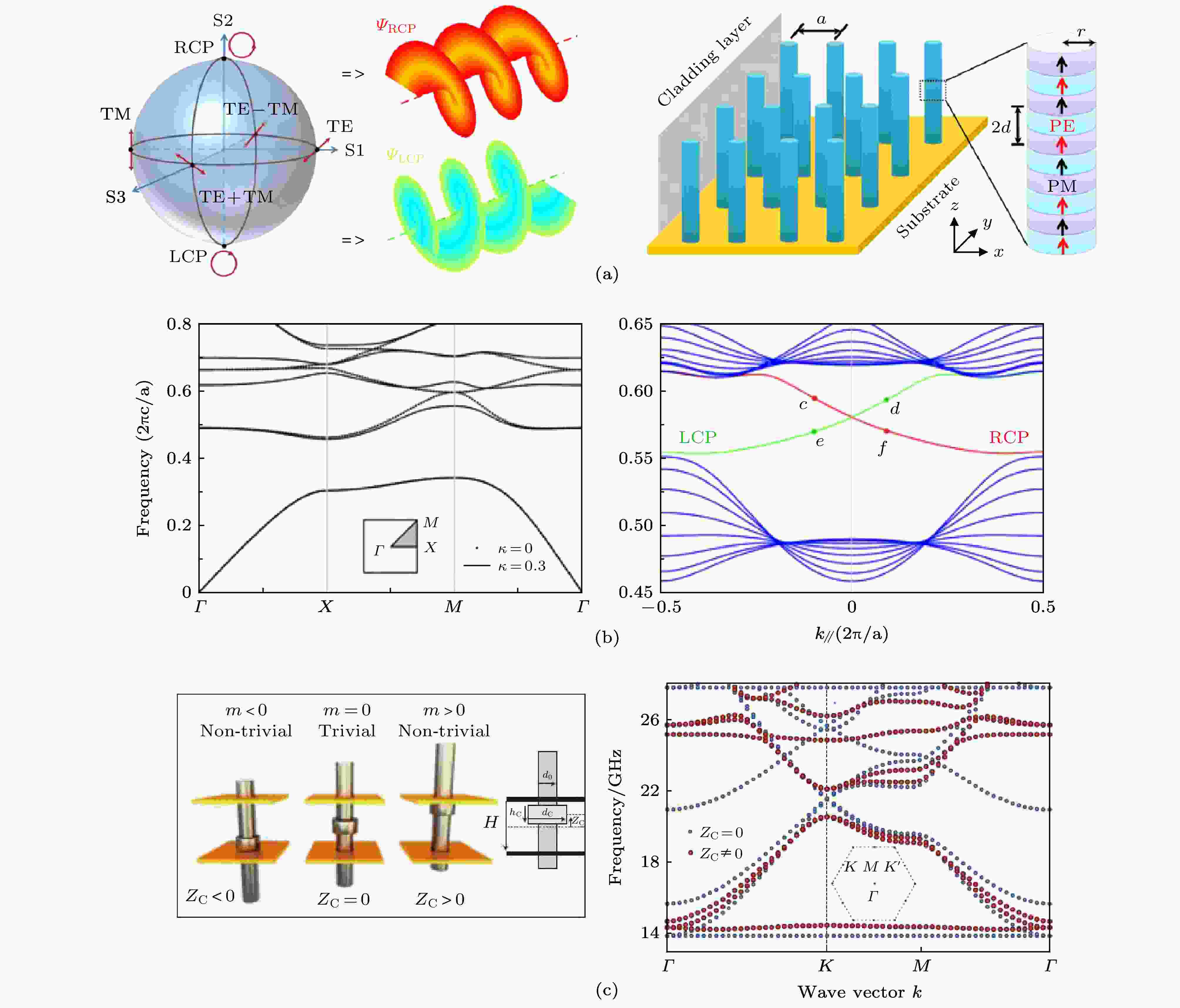全文HTML
--> --> -->拓扑光子学最初思想来源于固态物理中的物质拓扑相, 而这一领域的巨大发展则是始于1980年, 德国物理学家Klitzing等[25]发现的整数量子霍尔效应. 也就是二维电子气的霍尔电导在垂直的强磁场下会出现与磁场强度相关的平台, 其数值为

在凝聚态领域的拓扑相研究不断发展过程中, Haldane和Raghu开始意识到这种拓扑能带结构事实上是波在非均匀介质中普遍存在的属性, 2008年, 他们开创性地提出在具有Dirac点能带结构的光子晶体体系中, 通过引入磁光材料来打破时间反演对称性, 从而使得系统具有非零拓扑不变量[1]. 这一思想很快由Wang等[2,3]利用二维磁性光子晶体在微波频段得到了证实, 并且实验观测到了具有鲁棒性的单向传输的边界态. 然而, 光学领域整数量子霍尔效应模型的实现在普遍意义上仍然具有较大困难, 这主要是因为在光学领域中, 磁光响应的材料几乎不存在. 为此, 人们提出了诸多新的方案, 这些方案也极大地促进了拓扑光子学的发展. 2011年Hafezi等[33]提出将耦合环形谐振腔中的赝自旋作为光子的内禀自由度, 类比电子体系量子自旋霍尔系统, 实现了光学量子自旋霍尔效应. 有趣的是在这种体系中, 整体的时间反演对称性并没有被打破, 但每个赝自旋都感受到了相应的人工磁场. 借鉴构造赝自旋的思想, 2013年, Khanikaev等[9]利用电磁波超材料, 在TE/TM构成的左旋(LCP)、右旋(RCP)圆偏振为赝自旋的体系中, 发现了自旋依赖的拓扑边界态. 2012年, Fang等[16]受凝聚态中Floquet拓扑绝缘体的启发, 在光学谐振腔耦合阵列中加入了动态调制, 从而产生了时间依赖的哈密顿量, 实现了打破时间反演对称性的效果. 同年, Kraus等[34]利用一维波导阵列在传输方向上等价时间相关调制的特性, 在准晶排列的体系中实现了绝热泵浦, 并实验观测到了拓扑保护的边界态. 同样利用这种特性, Rechtsman等[15]于2013年, 在由螺旋形波导阵列组成的蜂窝状光子晶体中, 观测到了拓扑保护的边界态演化. 直至目前, 拓扑光子学领域仍朝着在多种光学耦合体系内实现更丰富的拓扑特性而努力.
最近几年, 光学领域与拓扑相的结合更加密切, 由此催生了一些新颖的研究方向. 其中最引人瞩目的有以下三点: 其一, 由于光学体系材料增益损耗的引入并不十分困难, 事实上在很多情形下(例如在光传输与耦合等系统中)增益损耗的考虑是必须的, 由此触发了人们对非厄米拓扑光子体系的研究[35-50]; 其二, 非线性过程是光学领域长久以来的课题, 随着拓扑相概念为越来越多人熟知, 具有非线性光学效应的拓扑构型也随之产生并向着更加丰富的内容发展[13,17,51-61]; 其三, 高阶拓扑相概念虽然起源于电子体系的紧束缚模型, 但在光子领域由于其有可能实现具有拓扑保护的局域场操控, 因此也越来越为人所关注[62-76].
本文从拓扑光子体系的维度调控出发, 阐述不同维度的光子拓扑现象以及相对应的拓扑相描述手段, 并针对当前拓扑光子领域研究的新热点问题进行探讨. 首先从Su-Schrieffer-Heeger (SSH)模型出发, 介绍具有手性对称性的一维光子体系的拓扑特性及相关的物理效应; 然后分别结合光子能带结构, 介绍二维、三维光子体系中拓扑现象, 特别是拓扑相描述手段与物理耦合平台; 最后, 本文将对当前拓扑光子学领域的新物理、新效应以及新的发展方向作一个简要的总结与展望.
 图 1 SSH模型示意图, 每个元胞包含两个格点
图 1 SSH模型示意图, 每个元胞包含两个格点Figure1. Schematic of the SSH model, there are two sites in each unit cell.










光子体系SSH模型的实验观测始于2009年的Malkova等[79]. 从此以后, 大量的研究主要集中在两个方面: 一方面是不同的电磁波系统的SSH模型, 例如微波光子晶体[80]、耦合波导阵列[81-83]、等离子[84]或纯介质腔[85]、波导环形谐振腔[86,87]等; 另一方面是基于SSH模型的推广与应用. 关于后者的研究, 我们举两类例子加以说明. 一类是利用SSH模型的局域边界态实现光学激射, 例如2017年St-Jean等[88]利用微纳加工工艺在一维拓扑边界上观测到了激光的产生. 如图2(a)所示, 通过微纳加工工艺将量子阱(QWs)放置在分布式布拉格反射(DBR)微腔中, 利用单个柱子的Px, Py两种偶极子模式之间的耦合, 如图2(b)所示, 在P态两条能带之间的带隙中观测到了局域的边界态并实现激光的激发, 如图2(c)所示. 2018年, Parto等[86]设计并实验制备了基于SSH模型的波导环形谐振腔阵列, 并实现了边界态的激发, 如图2(d)所示, 通过上下耦合波导通道, 可以在边界的耦合波导中得到相应的局域边界态. 另一类是将SSH模型与量子光学相结合. 典型的是2012年, Kitagawa等[89]提出的把单光子进行一系列的极化旋转, 实现拓扑非平庸的离散时间量子行走, 在不同Zak相位结构的界面处观测到了局域的拓扑边界态. 随后一维量子行走系统的拓扑不变量测量与鲁棒性测试也相继提出[90,91]. 2017年, Cardano等[92]在轨道角动量空间实现量子行走的拓扑相转变, 使得这个方向更加的引人注目.
 图 2 (a) 微纳加工(SSH 模型)的SEM图; (b) 单个柱子的模式; (c) 不同能带中的态及存在的边界态; (d) 利用波导环形阵列实现SSH模型
图 2 (a) 微纳加工(SSH 模型)的SEM图; (b) 单个柱子的模式; (c) 不同能带中的态及存在的边界态; (d) 利用波导环形阵列实现SSH模型Figure2. (a) SEM image of the coupled micropillars; (b) Modes of single micropillars; (c) Different modes of the micropillar array and edge states; (d) SSH microring array.
3.1.基于二维拓扑光学系统的整数量子霍尔效应
如前文所述, 光的整数量子霍尔效应的提出充分借鉴了凝聚态电子气体系的经验. Haldane和Raghu在提出光学体系量子霍尔效应时便是基于凝聚态物理中无质量的Dirac方程[1]. 以类石墨烯体系为例, 它的能带在倒易空间的K与K′处形成具有线性色散关系的Dirac点, 这种高对称点附近的准粒子特性可以通过哈密顿量HD来描述:

2008年, Wang等[2]意识到构造线性色散Dirac点并非产生量子霍尔效应的必然条件, 他们利用忆铁石榴石铁氧体(YIG)的旋磁特性(即磁张量的非对角项μij在外加磁场下不为零), 在具有四方点阵结构的光子晶体中构造出了陈数不为零的拓扑绝缘体, 并于2009年在实验上观测到背散射抑制的拓扑边界态[3], 如图 3(a)和图3(b). 随后, Skirlo等[4]利用铁磁光子晶体在高能带上设计并观测到了大陈数的拓扑绝缘体, 其相邻两条能带的陈数差大于1, 即: Cgap > 1, 对应于更多条数的边界态, 如图 3(c)和图3(d)所示. 这种效应在诸如光学耦合腔[93,94]、光子晶体板[95]、动态调制谐振器[96]等不同的耦合平台上也被先后实现.
 图 3 (a) 旋磁光子晶体的示意图; (b) 向前向后的传输谱以及具有手性边界态的投影能带; (c) 大陈数光子晶体结构图; (d) 能带的带隙及其陈数
图 3 (a) 旋磁光子晶体的示意图; (b) 向前向后的传输谱以及具有手性边界态的投影能带; (c) 大陈数光子晶体结构图; (d) 能带的带隙及其陈数Figure3. (a) Schematic of the gyromagnetic photonic crystal; (b) forward and backward spectra, and projected band structures with chiral edge states; (c) the diagram of large Chern number photonic crystals; (d) the band gap map and their Chern number.
2
3.2.二维光量子自旋霍尔效应
拓扑光子学中的另一大类就是保持时间反演(或赝时间反演)对称性的量子自旋霍尔效应系统. 对电子系统来说, 由于电子本身具有 ± 自旋, 因此对于每一个自旋s都可以利用(5)式单独地指定一个陈数C↑, ↓, 来表示有相应自旋的能带. 因此拓扑不变量可以用两种量表征, 一种是传统的陈数C, 另一种则是自旋陈数Cs.
光子系统的自旋与电子的内禀自旋还是有很大不同的, 目前主要有三种方案来实现光子的自旋霍尔效应. 第一种方案是利用光子的偏振自由度. 2013年, 德克萨斯大学奥斯汀分校的Khanikaev等[9]利用光的TE与TM偏振自由度, 构造了两种赝自旋态TE+TM与TE-TM. 通过控制偏振的耦合, 系统实现了自旋轨道的耦合并产生量子自旋霍尔效应. 然而这一工作没有说明时间反演对称性与此现象的关系. 2016年, 南京大学He等[97]提出了一种基于压电(PE)—压磁(PM)超晶格的光子晶体模型, 并以左旋(LCP)和右旋(RCP)光为赝自旋态, 如图4(a)所示. 模型采用了四方晶格构型, 并保证了时间反演破缺, 而仅保存了电磁耦合与时间反演联合的对称性(赝时间反演对称性), 从而证实时间反演对称性本身也只是针对于固有的电场磁场系统, 即使时间反演对称性破缺, 光量子自旋霍尔效应仍然可以发生, 如图4(b)所示. (赝)自旋态的选取发生改变, 相应的(赝)时间反演对称性算符也可能发生改变, 这对理解时间反演对称性在光量子自旋霍尔效应中的角色起到了很大作用. 2014年, Chen等[20] 利用微波超构材料在实验上观测到了以TE+TM和TE-TM为赝自旋态的量子自旋霍尔效应.
 图 4 (a) Poincaré球上的LCP和RCP, 以及由PE和PM材料构成的光子晶体; (b) 没有赝自旋耦合以及具有赝自旋耦合的能带以及后者的投影能带; (c) 通过调节金属柱子实现赝自旋的耦合
图 4 (a) Poincaré球上的LCP和RCP, 以及由PE和PM材料构成的光子晶体; (b) 没有赝自旋耦合以及具有赝自旋耦合的能带以及后者的投影能带; (c) 通过调节金属柱子实现赝自旋的耦合Figure4. (a) The polarization of LCP and RCP on the Poincaré sphere, and the photonic crystal consisting of PE and PM superlattices; (b) band structures without coupling between dseudospin states and with their coupling, and the projected band structures for the latter case; (c) photonic crystals consisting of metallic rods and collars at different positions, and their band strucutres.
第二种产生光量子自旋霍尔效应的方案是通过晶格对称性来实现, 这种方案最早由Wu和Hu[6]在2015年提出. 如图 5所示, 对于同一类偏振态而言, 利用蜂窝结构的位于K和K'的狄拉克点以及能带折叠概念, 当柱子距中心距离为高对称的石墨烯参数时, 系统在Γ点实现四重简并的Dirac点. 而当结构距离参数发生改变时, Γ点双Dirac点发生去简并, 出现两两简并的px, py和dxy,

 图 5 (a) 全介质光子晶体结构; (b) 收缩、高对称以及扩张晶格所对应的能带; (c) 赝自旋依赖的边界态的实验观测
图 5 (a) 全介质光子晶体结构; (b) 收缩、高对称以及扩张晶格所对应的能带; (c) 赝自旋依赖的边界态的实验观测Figure5. (a) Schematic of all-dielectric photonic crystals; (b) band structures of shrinking and expanding lattices; (c) visualization of pseudospin-dependent edge states.
第三种方案是利用光在环形谐振腔体系的耦合来实现的. 通过控制光沿着谐振腔顺时针和逆时针传播的路径, 使得系统具有类比于电子自旋的自由度, 由于这样的系统天然保持了时间反演对称性, 因此可以类比于量子自旋霍尔效应. 如图6所示, Hafezi等[22,33,98]利用耦合环将两个环形谐振腔相连并以此为单元构成周期耦合阵列, 提出并在实验上实现了具有自旋量子霍尔效应的光学腔传输边界态, 在单一自旋下具有单向传输且缺陷免疫的特性.
 图 6 (a) 谐振腔耦合单元; (b) 周期排布形成的耦合阵列
图 6 (a) 谐振腔耦合单元; (b) 周期排布形成的耦合阵列Figure6. (a) Two coupled resonators in one unit cell; (b) a periodic array arranged by unit cells.
2
3.3.光Floquet拓扑绝缘体
通过在哈密顿量中引入时间调制或等效于时间的调制, 也可以使得材料产生新奇的拓扑特性, 通常这一类拓扑绝缘体被称为Floquet拓扑绝缘体. 2012年, Fang等[16]将这一思想引入光子晶体体系, 从而实现了光学的Floquet拓扑绝缘体. 如图7(a)所示, 通过在光学谐振腔耦合阵列中引入耦合相关的动态调制
 图 7 (a) 光学谐振腔阵列的动态调制; (b) 激光直写波导系统的拓扑绝缘体构型; (c) 四种耦合组成的周期构型
图 7 (a) 光学谐振腔阵列的动态调制; (b) 激光直写波导系统的拓扑绝缘体构型; (c) 四种耦合组成的周期构型Figure7. (a) The resonator lattice with dynamic modulation; (b) floquet topological insulators using the femtosecond laser writing method; (c) four different bonds with different coupling.


4.1.外尔(Weyl)点和节线(nodal-line)
类比于二维体系的Dirac点, 在三维系统中可以找到与之对应的点, 即外尔(Weyl)点, 它对应于在三维动量空间都具有线性色散的简并点. Weyl点附近的色散关系可以通过哈密顿量HW表示 图 8 (a) 能够产生Weyl点以及节线的双螺旋光子晶体; (b) 具有Weyl点的金属夹杂的光子晶体
图 8 (a) 能够产生Weyl点以及节线的双螺旋光子晶体; (b) 具有Weyl点的金属夹杂的光子晶体Figure8. (a) Photonic crystals with two gyroid structures in one unit cell, and their band structures with Weyl points or nodal-line; (b) schematic of photonic crystals with the saddle-shaped metallic inclusion, and their Weyl points.
在三维体系中, 还存在一类奇特的简并点, 其能带沿着三维布里渊区的一条线简并形成所谓的节线(nodal-line). 这种节线在一定对称性保护下可以具备拓扑稳定性, 并且每个节线具有π的贝利相位. 例如, 一个简化的双能级的节线模型的哈密顿量可以表示为




2
4.2.三维光学拓扑绝缘体
在三维光子晶体体系中, 拓扑绝缘体产生的关键在于利用拓扑简并点(例如Weyl点和Dirac点)得到三维k空间中的非平庸能带带隙, 从而支持各种拓扑界面态. 截至目前, 已提出的三维光学拓扑绝缘体机制主要有三维光整数量子霍尔效应、三维光量子自旋霍尔效应等. 三维光整数量子霍尔效应可以通过三个第一陈数刻画, 即
三维光量子自旋霍尔效应则是通过直接构造Dirac点来实现, 这种方案最早由Slobozhanyuk等[113,114]于2016年提出, 他们将双各向异性超构材料组合成新的光子晶体, 利用电场和磁场之间的交错耦合, 构造出了新的赝自旋自由度, 如图9(a)所示. 通过控制三维结构的空间分布, 高对称点处的Dirac点被打开, 实现了拓扑保护的界面态, 如图9(b)所示. 2019年, Yang等[115]在三维光子超材料中, 利用金属劈裂环谐振腔(SRRS)操纵Dirac点的打开, 也实现了微波频段的三维拓扑绝缘体. 在三维光量子自旋霍尔效应的设计中, 还存在一种由旋磁材料光子晶体构造Dirac点的情况, 其拓扑带隙的打开需要引入外加磁场, 如图9(c)所示. 然而由于光频段材料对磁场的响应十分有限, 因此这种设计在实验上存在一定难度并且在应用上也存在很大限制[116].
 图 9 (a) 三维全介质与双各向异性光子晶体; (b) 两种构型的光子晶体对应的能带; (c) 通过引入磁场破缺Dirac点的光子晶体构型
图 9 (a) 三维全介质与双各向异性光子晶体; (b) 两种构型的光子晶体对应的能带; (c) 通过引入磁场破缺Dirac点的光子晶体构型Figure9. (a) 3 D all-dielectric and bianisotropic metacrystals; (b) band structures corresponding to two structures in (a); (c) photonic crystals with opened Dirac points when magnetization is applied on rods.
事实上, 通过操纵三维晶格对称性, 光子晶体有可能实现Z2拓扑绝缘体所具有的特点, 这种拓扑晶体绝缘体最早由Fu[117]于2011年提出. 2017年, Ochiai[118]利用三维立方光子晶体, 提出了偶然简并导致的无能隙的界面态. 至此, 产生三维拓扑绝缘体的各种机制的探索、相应拓扑保护的界面态传输特性的研究变得越来越清晰.
5.1.非厄米拓扑光子效应
在光子系统中引入增益与损耗相比在电子体系中具有更大优势, 例如增益材料在光能量补偿及光场放大中发挥着重要作用, 而所有光学器件都不可避免地具有光子的损耗. 通过在光学系统中引入增益和损耗, 传统光学系统可以从非厄米性的视角进行分析与设计, 将会为系统带来更为丰富的物理性质. 目前, 非厄米体系的研究主要基于两点, 其一是拓扑相以及体边对应关系的探索, 另一方面是非厄米体系对称性的研究, 主要为宇称时间反演对称性(PT symmetry). 为了便于讨论, 这里从简单的阶梯模型出发[35, 119]. 如图10(a)所示, 当考虑非厄米的引入时, 系统的哈密顿量可以写作 图 10 (a) 动量空间中的奇异点以及具有增益损耗的紧束缚模型; (b) 具有增益损耗的波导阵列; (c) 具有奇异环的光子晶体板结构
图 10 (a) 动量空间中的奇异点以及具有增益损耗的紧束缚模型; (b) 具有增益损耗的波导阵列; (c) 具有奇异环的光子晶体板结构Figure10. (a) Exceptional points in momentum space, and the tight-binding model with gain and loss for αi and βi; (b) the waveguide array with gain and loss; (c) photonic crystal slabs with the ring of exceptional points.



(12)式中的哈密顿量与PT算符对易. 如果所有哈密顿量的本征值也是PT算符的本征值, 此时的本征值将为实数. 值得注意的是, 此模型具有一个只存在于系统一端的零能边界态, 这与厄米系统中的体边对应关系(分数绕数)有所不同, 是非厄米矩阵出现缺陷的结果. 2015年, Zhen等[120]将光子晶体板的辐射损耗视为材料损耗, 在此体系中观察到了由奇异点构成的环. 此工作展示了非厄米的引入在能带和群速度调控中的重要作用, 如图10(c)所示. 2017年, Weimann等[121]利用一维激光直写波导阵列实现了非厄米体系的拓扑保护的边界态, 如图10(b)所示, 展示了非厄米性在具有增益(或损耗)的边界态传输上的应用前景. 直至最近, 宾夕法尼亚大学Zhao等[122]提出, 利用耦合环形谐振腔阵列, 在同一种拓扑相结构的内部, 当边界两侧引入的增益损耗之差超过奇异点时, 边界上可以实现可重构的单向手性拓扑边界态, 这展示了非厄米的引入对拓扑边界态调控的巨大影响.
在这些新奇的物理效应不断被发现之际, 相应的拓扑分类与体边对应关系也变成研究者非常关心的问题. 目前提出的非厄米体系拓扑分类方式主要有以下两种. 一种方式是2018年由Shen等[48]提出的, 将能带分为可分离的(即对于所有m ≠ n和k, 本征值都满足


2
5.2.非线性拓扑光子效应
非线性光学是近代光学的重要分支, 对光谱技术、成像技术以及光学信息处理技术的发展具有重要的意义. 半经典的非线性过程可以通过在麦克斯韦方程中引入非线性项实现, 是电极化矢量对电场的非线性响应的结果, 可以表示为[128,129] 图 11 (a) 非线性SSH模型; (b) 与光强度相关的环绕数(贝利相位); (c) 将量子比特与它们的耦合器铺成二维格子的示意图; (d) 包含三个超导量子比特的超导回路
图 11 (a) 非线性SSH模型; (b) 与光强度相关的环绕数(贝利相位); (c) 将量子比特与它们的耦合器铺成二维格子的示意图; (d) 包含三个超导量子比特的超导回路Figure11. (a) The nonlinear SSH model; (b) the winding number (Berry phase) changed by intensity; (c) schematic diagram of qubits and their couplers in 2 D lattice; (d) the superconducting circuit including three qubits.




当非线性效应很强时, 系统会展现出光子的离散特征, 需要用量子的手段描述. 在强非线性光子拓扑效应中, Rydberg-EIT(电磁感应透明)配置的包含一致性原子气体的非平面腔[131]以及强非线性作用的超导QED回路[132]是两个的重要平台. 例如, 2011年Reinhard等[133]利用片上集成的QED腔, 展示了基于量子强非线性效应的光子阻塞效应, 即在单模非线性谐振腔中, 满足空腔共振模式的入射光束, 当第一个光子自由地进入腔体后, 对第二个光子来说有效谐振频率将会发生偏移, 使得只有第一个光子离开后第二个才能进入. 将光子阻塞效应与人工合成势场相结合, 就产生了丰富的强非线性拓扑光子效应. 2016年, Roushan等[132]利用超导量子比特与耦合器(超导QED回路)构造出有效的晶格结构, 实现了合成磁场与粒子间的强相互作用. 通过正弦调制比特间的耦合来引入人工磁场, 可以在三个比特构成的回路中观测到打破时间反演对称性的光子定向流动, 这种设计为强相互作用的量子相位调控构造了一个有效的平台. 2018年, Jia等[131]将Rydberg EIT与光学谐振腔相结合, 前者提供了针对单光子非线性的原子传感器, 而后者则加强了光与物质的相互作用, 由此证实了第一个强相互作用的极化子量子点, 为拓扑多光子态的制备提供了思路. 由于光子的寿命相对较长, 实验中只需在起始时制备单光子和双光子的Fork态[132,134], 之后在没有泵浦的情况下测量光子的演化即可, 相关的实验与理论还在不断的发展与完备之中.
2
5.3.高阶拓扑光子效应
通常认为, 一个N维的拓扑光子体系其拓扑边界态为N-1维, 这使得我们在局域场维度上的调控十分有限. 最近研究表明, 一些拓扑绝缘体具有
 图 12 (a) 介质柱构成的二维SSH模型的光子晶体; (b) 收缩、高对称与扩张晶格构型的能带结构; (c) 由收缩区域包围扩张区域构成的整体结构, 解的序号与本征频率的关系; (d) 实验中放于一个角的源激发的拐角态
图 12 (a) 介质柱构成的二维SSH模型的光子晶体; (b) 收缩、高对称与扩张晶格构型的能带结构; (c) 由收缩区域包围扩张区域构成的整体结构, 解的序号与本征频率的关系; (d) 实验中放于一个角的源激发的拐角态Figure12. (a) Photonic crystals of the 2D SSH model consisting of dielectric pillars; (b) band structures of shrinking, high symmetry and expending structures; (c) shrinking supercells contain expanding supercells, and the relationship between solution numbers and eigenfrequencies; (d) experimentally measured corner states when the source is placed at the corner.





光子体系与凝聚态物理中的电子等体系相比, 无论从结构设计, 还是调控方式, 均具有更高的自由度, 在某些方面能够构造出与其他自然材料体系相比更为完美的物理模型以及测量到更加丰富的物理量. 因此, 拓扑光子学已经成为研究拓扑物理机制的重要平台. 并且, 从光场操控角度而言, 具有拓扑保护的、背向散射抑制的边界态以及高阶拓扑态, 在光学输运、场维度调控以及量子的光学传输等方面都有巨大的基础研究和应用前景.
当然, 目前拓扑光子学领域也面临一些挑战, 其中很重要的一方面是集成化拓扑光子器件的挑战, 通信波段的光子器件与现有的硅基半导体工艺相结合将在光通信、光计算方向具有较大前景, 然而中红外甚至更短波长的应用波段使得拓扑光子器件需要做得更小, 这受制于微纳加工工艺以及拓扑结构设计; 另一方面是可调谐性的挑战, 可调谐拓扑光子体系的构建受制于光学材料的特性, 通常光学材料可以通过热光、电光、声光以及磁光等方式调控, 然而它们在调制速率、调制幅度等方面都具有各种局限性; 此外是理论与设计上的挑战, 例如在非厄米系统体边对应关系、三维(或更高维度)光子拓扑绝缘体和高阶拓扑绝缘体等方面仍有许多亟待研究的问题.
